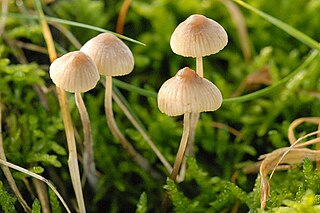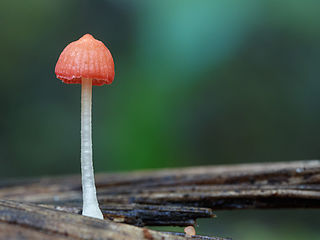
Rolf Singer was a German-born mycologist and one of the most important taxonomists of gilled mushrooms (agarics) in the 20th century.

Pleurotus is a genus of gilled mushrooms which includes one of the most widely eaten mushrooms, P. ostreatus. Species of Pleurotus may be called oyster, abalone, or tree mushrooms, and are some of the most commonly cultivated edible mushrooms in the world. Pleurotus fungi have been used in mycoremediation of pollutants such as petroleum and polycyclic aromatic hydrocarbons. Oyster mushrooms contain lovastatin, a form of cholesterol lowering statin.

William Alphonso Murrill was an American mycologist, known for his contributions to the knowledge of the Agaricales and Polyporaceae. In 1904, he became the assistant Curator at the New York Botanical Garden (NYBG). He, along with the NYBG, founded the journal Mycologia and was its first editor for 16 years. Murrill was known to travel extensively to describe the mycota of Europe and the Americas. He traveled along the East Coast, Pacific Coast, Mexico and the Caribbean. Although Murrill was a very influential person at the NYBG, having worked his way up to become assistant director in 1908, his rather eccentric personality caused problems with his job. He went on annual collecting trips to Mexico, the Caribbean, Europe, and South America, sometimes, without informing any of his colleagues prior. These trips resulted in a cumulative total of 70,000 specimens, 1,400 of which are deposited in the NYBG.
Gastón Guzmán Huerta, a Mexican mycologist and anthropologist, was an authority on the genus Psilocybe.
Marasmiellus cocophilus is a species of fungus in the family Marasmiaceae. It was described as new to science in 1969 by mycologist David Pegler. The fungus causes lethal bole rot of coconut.
Marasmiellus scandens is a plant pathogen that causes white thread on cocoa.
Marasmiellus stenophyllus is a plant pathogen that causes Marasmius sheath and shoot blight on sugarcane.
Marasmiellus inoderma is a fungus in the family Marasmiaceae. It is a plant pathogen that causes root-rot of maize, Marasmiellus rot on banana and basal rot of golden shower orchid.

Collybia is a genus of mushrooms in the family Tricholomataceae. The genus has a widespread but rare distribution in northern temperate areas, and contains three species that grow on the decomposing remains of other mushrooms.

Mycena flavoalba, commonly known as the ivory bonnet, is a species of inedible mushroom in the family Mycenaceae. The cap is initially conical in shape, before becoming convex and then flattening out; it may reach dimensions of up to 1.5 cm (0.6 in) across. The cap color is ivory-white to yellowish white, sometimes more yellowish at the center. The tubular stems are up to 8 cm (3.1 in) long and 2.5 mm (0.10 in) thick, and have long, coarse white hairs at their bases. The mushroom is found in Europe, the Middle East, and North America, where it grows scattered or in dense groups under conifers and on humus in oak woods.

Gymnopus is a genus of fungus in the family Omphalotaceae. The genus has a widespread, cosmopolitan distribution and contains about 300 species.

Marasmiellus is a genus of fungi in the family Marasmiaceae. The widespread genus, circumscribed by American mycologist William Murrill in 1915, contains about 250 species. The name comes from the Greek marasmus meaning wasting.

Archaeomarasmius is an extinct genus of gilled fungus in the Agaricales family Tricholomataceae, containing the single species Archaeomarasmius leggetti. It is known from two fruit bodies recovered from amber, one consisting of a complete cap with a broken stem, the other consisting of a fragment of a cap. The cap has a diameter ranging from 3.2 to 6 mm, while the stem is 0.5 mm (0.02 in) thick. Spores were also recovered from the amber, and are broadly ellipsoid to egg-shaped, measuring roughly 7.3 by 4.7 μm. The species, which resembles the extant genera Marasmius and Marasmiellus, is inferred to have been saprobic on plant litter or other forest debris.

Setulipes was a proposed genus of fungi in the family Marasmiaceae. This group of mushrooms, described by the Czech mycologist Vladimír Antonín in 1987, has a widespread distribution in north temperate areas, and would contain about 25 species.

Marasmiellus hapuuarum is a species of agaric fungus in the family Marasmiaceae. Formally described in 2011, it is known only from Hawaiian montane wet forests where it grows on aging hāpuʻu plants. The fungus produces small pinkish-buff fruit bodies up to 0.6 cm (0.24 in) in diameter, with distantly spaced narrow gills.

Mycena marasmielloides is a species of agaric fungus in the family Mycenaceae. Newly described to science in 2011, it is known only from Hawaiian montane wet forests. The species produces tiny mushrooms with pale brown to grayish caps up to 5 mm in diameter, held by thin curved stems up to 4 mm long.

Atheniella is an agaric fungal genus that produces mostly brightly colored mycenoid fruit bodies on small plant debris on forest floors, in fields and bogs. It is not a member of the Mycenaceae, and unlike most Mycenaceae, its basidiospores and tissues do not react with iodine. Atheniella species were most recently classified in Mycena because of their stature. However, they lack amyloid spores and tissues bewildering taxonomists, leading to temporary placements in Hemimycena and Marasmiellus before being phylogenetically excluded from both genera and the Mycenaceae.

Phloeomana is a bark-inhabiting agaric fungal genus that produces fuscous-colored to whitish mycenoid to omphalinoid fruit bodies in temperate forests. In addition to the type species Phloeomana speirea, 4 other species, P. alba, P. clavata, P. hiemalis and P. minutula, have been placed in the genus. The genus is characterized by nonamyloid smooth, hyaline (translucent) basidiospores and tissues, poorly to moderately differentiated cheilocystidia, diverticulate pileipellis hyphae and general smooth stipe hyphae with scattered caulocystidia. It is one of several mushroom genera formerly classified most recently in Mycena, Omphalina, Hydropus, or Marasmiellus. Phylogenetically, Phloeomana is distant from the Mycenaceae and is closest to a clade or group that includes other former members of Mycena now in Atheniella and Hemimycena clearly excluded from the Mycenaceae and tentatively classified in the Porotheleaceae.
Marasmius asiaticus is a species of agaric fungus in the family Marasmiaceae. Within the large genus Marasmius, it is classified in section Sicci. Known only from a single collection made in Mount Nuang Forest Reserve, it was described as new to science in 2009 by Tan and Dennis Desjardin under the name Marasmius distantifolius. This was later discovered to be an illegitimate homonym of a species named by William Alphonso Murrill in 1915, now known as Marasmiellus distantifolius. Armin Mešić and Zdenko Tkalčec proposed the new epithet asiaticus, referring to its distribution. The original epithet, which combined the Latin distans ("distant") and -folius ("leaf"), alluded to the distantly-spaced gills.
Gymnopus moseri is a European species of agaric fungus in the family Omphalotaceae. It was described as new to science in 1997 by mycologists Vladimír Antonín and Machiel Noordeloos from collections made in Sweden. Fruit bodies of the holotype collection were found growing among Polytrichum and in coarse humus and leaves under birch (Betula) and willow (Salix). Collybia moseri is a synonym proposed by Marcel Bon in 1998. The specific epithet moseri honours Austrian mycologist Meinhard Michael Moser.












